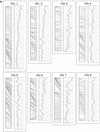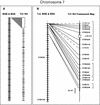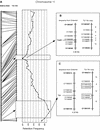The comprehensive mouse radiation hybrid map densely cross-referenced to the recombination map: a tool to support the sequence assemblies
- PMID: 12529315
- PMCID: PMC430952
- DOI: 10.1101/gr.858103
The comprehensive mouse radiation hybrid map densely cross-referenced to the recombination map: a tool to support the sequence assemblies
Abstract
We have developed a unique comprehensive mouse radiation hybrid (RH) map of nearly 23,000 markers integrating data from three international genome centers and over 400 independent laboratories. We have cross-referenced this map to the 0.5-cM resolution recombination-based Jackson Laboratory (TJL) backcross panel map, building a complete set of RH framework chromosome maps based on a high density of known-ordered anchor markers. We have systematically typed markers to improve coverage and resolve discrepancies, and have reanalyzed data sets as needed. The cross-linking of the RH and recombination maps has resulted in a highly accurate genome-wide map with consistent marker order. We have compared these linked framework maps to the Ensemble mouse genome sequence assembly, and show that they are a useful medium resolution tool for both validating sequence assembly and elucidating chromosome biology.
Figures





Similar articles
-
Cross-referencing radiation hybrid data to the recombination map: lessons from mouse chromosome 18.Genomics. 2000 Oct 1;69(1):27-36. doi: 10.1006/geno.2000.6314. Genomics. 2000. PMID: 11013072
-
A high-resolution radiation hybrid map of chicken chromosome 5 and comparison with human chromosomes.BMC Genomics. 2004 Sep 15;5:66. doi: 10.1186/1471-2164-5-66. BMC Genomics. 2004. PMID: 15369602 Free PMC article.
-
A gene-based high-resolution comparative radiation hybrid map as a framework for genome sequence assembly of a bovine chromosome 6 region associated with QTL for growth, body composition, and milk performance traits.BMC Genomics. 2006 Mar 16;7:53. doi: 10.1186/1471-2164-7-53. BMC Genomics. 2006. PMID: 16542434 Free PMC article.
-
The chicken RH map: current state of progress and microchromosome mapping.Cytogenet Genome Res. 2007;117(1-4):14-21. doi: 10.1159/000103160. Cytogenet Genome Res. 2007. PMID: 17675840
-
Facilitating genome navigation: survey sequencing and dense radiation-hybrid gene mapping.Nat Rev Genet. 2005 Aug;6(8):643-8. doi: 10.1038/nrg1658. Nat Rev Genet. 2005. PMID: 16012527 Review.
Cited by
-
Integrating linkage and radiation hybrid mapping data for bovine chromosome 15.BMC Genomics. 2004 Oct 8;5:77. doi: 10.1186/1471-2164-5-77. BMC Genomics. 2004. PMID: 15473903 Free PMC article.
-
Random mutagenesis of proximal mouse chromosome 5 uncovers predominantly embryonic lethal mutations.Genome Res. 2005 Aug;15(8):1095-105. doi: 10.1101/gr.3826505. Epub 2005 Jul 15. Genome Res. 2005. PMID: 16024820 Free PMC article.
-
A high-resolution multistrain haplotype analysis of laboratory mouse genome reveals three distinctive genetic variation patterns.Genome Res. 2005 Feb;15(2):241-9. doi: 10.1101/gr.2901705. Genome Res. 2005. PMID: 15687287 Free PMC article.
-
A multi-megabase copy number gain causes maternal transmission ratio distortion on mouse chromosome 2.PLoS Genet. 2015 Feb 13;11(2):e1004850. doi: 10.1371/journal.pgen.1004850. eCollection 2015 Feb. PLoS Genet. 2015. PMID: 25679959 Free PMC article.
-
Development of a deer mouse whole-genome radiation hybrid panel and comparative mapping of Mus chromosome 11 loci.Mamm Genome. 2006 Jan;17(1):37-48. doi: 10.1007/s00335-005-0051-x. Epub 2006 Jan 13. Mamm Genome. 2006. PMID: 16416089
References
-
- Arkell R.M., Cadman, M., Marsland, T., Southwell, A., Thaung, C., Davies, J.R., Clay, T., Beechy, C.V., Evans, E.P., Strivens, M.A., et al. 2001. Genetic, physical, and phenotypic characterization of the Del13Svea36H mouse. Mamm. Genome 12: 687-694. - PubMed
-
- Avner P., Bruls, T., Poras, I., Eley, L., Gas, S., Ruiz, P., Wiles, M.V., Sousa-Nunes, R., Kettleborough, R., Rana, A., et al. 2001. A radiation hybrid transcript map of the mouse genome. Nat. Genet. 29: 194-200. - PubMed
-
- Behboudi A., Roshani, L., Lundin, L., Stahl, F., Levan, K.K., and Levan, G. 2002. The functional significance of absence: The chromosomal segment harboring Tp53 is absent from the T55 rat radiation hybrid mapping panel. Genomics 79: 844-848. - PubMed
-
- Copeland N.G., Jenkins, N., Gilbert, D., Eppig, J.T., Maltais, L.J., Miller, J.C., Dietrich, W.F., Weaver, A., Lincoln, S.E., Steen, R.G., et al. 1993. A genetic linkage map of the mouse: Current applications and future prospects. Science 262: 57-66. - PubMed
Publication types
MeSH terms
Substances
Grants and funding
LinkOut - more resources
Full Text Sources
Molecular Biology Databases
